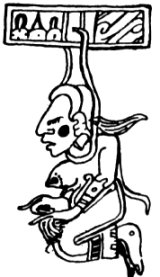
Ixtab
Encyclopedia
Ixtab or Rope Woman was the Yucatec Mayan goddess of suicide
according to Diego de Landa
. In Yucatec society, suicide, especially suicide by hanging, was under circumstances considered an honorable way to die. Ixtab would accompany such suicides to paradise (thus playing the role of a psychopomp
). Here, joined by people who died as soldiers or as sacrificial victims, by women who died in childbirth and by members of the priesthood, they enjoyed a delectable existence rewarded with delicious food and drink and resting under the shade of a pleasant tree, Yaxche, free from all want.
The picture of a dead woman with a rope around the neck in the Dresden Codex
is often taken to represent the goddess. Since it occurs in a section devoted to eclipses of sun and moon, it may have been used to symbolize a lunar eclipse and its dire consequences for women, especially pregnant ones: Lunar eclipses exposed their unborn children to the risks of deformation and death. No other pictures possibly representing Ixtab are known.
Suicide
Suicide is the act of intentionally causing one's own death. Suicide is often committed out of despair or attributed to some underlying mental disorder, such as depression, bipolar disorder, schizophrenia, alcoholism, or drug abuse...
according to Diego de Landa
Diego de Landa
Diego de Landa Calderón was a Spanish Bishop of the Roman Catholic Archdiocese of Yucatán. He left future generations with a mixed legacy in his writings, which contain much valuable information on pre-Columbian Maya civilization, and his actions which destroyed much of that civilization's...
. In Yucatec society, suicide, especially suicide by hanging, was under circumstances considered an honorable way to die. Ixtab would accompany such suicides to paradise (thus playing the role of a psychopomp
Psychopomp
Psychopomps are creatures, spirits, angels, or deities in many religions whose responsibility is to escort newly deceased souls to the afterlife. Their role is not to judge the deceased, but simply provide safe passage...
). Here, joined by people who died as soldiers or as sacrificial victims, by women who died in childbirth and by members of the priesthood, they enjoyed a delectable existence rewarded with delicious food and drink and resting under the shade of a pleasant tree, Yaxche, free from all want.
The picture of a dead woman with a rope around the neck in the Dresden Codex
Dresden Codex
The Dresden Codex, also known as the Codex Dresdensis, is a pre-Columbian Maya book of the eleventh or twelfth century of the Yucatecan Maya in Chichén Itzá. The Maya codex is believed to be a copy of an original text of some three or four hundred years earlier...
is often taken to represent the goddess. Since it occurs in a section devoted to eclipses of sun and moon, it may have been used to symbolize a lunar eclipse and its dire consequences for women, especially pregnant ones: Lunar eclipses exposed their unborn children to the risks of deformation and death. No other pictures possibly representing Ixtab are known.
Sources
- Landa's Relación de las cosas de Yucatán, ed. A.M. Tozzer (1941).
- J.E.S. Thompson, A Commentary on the Dresden Codex. Philadelphia 1972.

